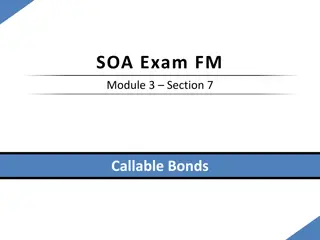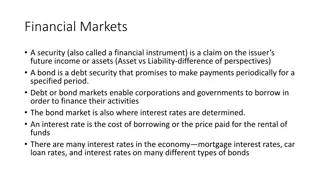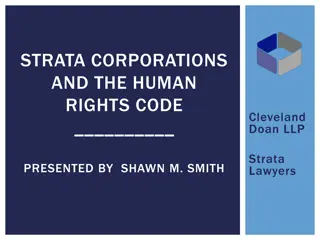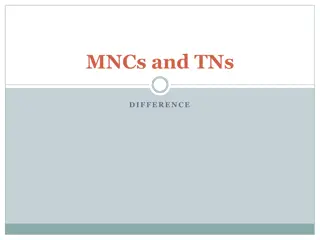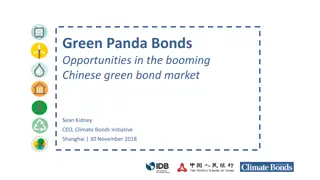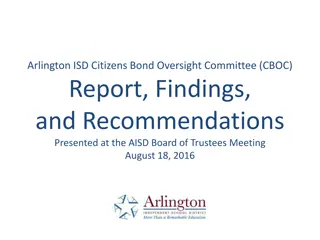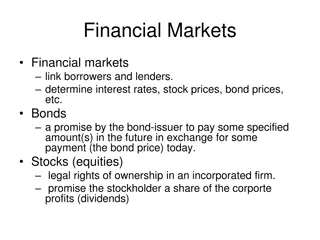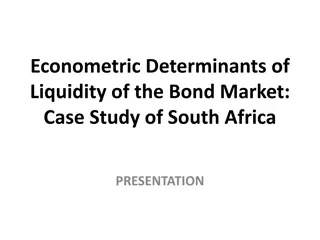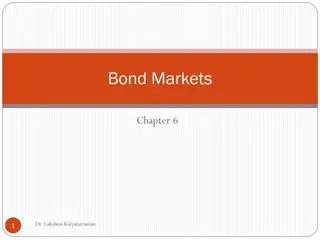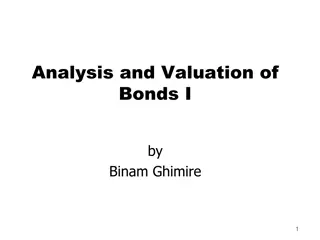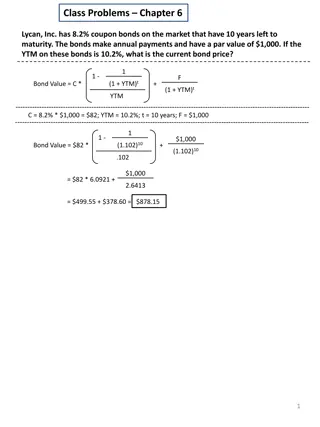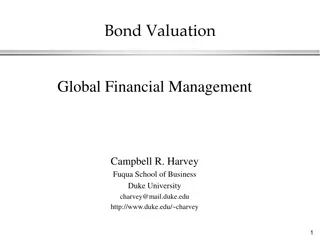Understanding the Significance of the Bond Market for Government and Corporations
The bond market serves as a crucial source for fundraising for governments and public corporations. Investors use money markets for short-term needs and capital markets for long-term investments to manage risks. Various types of bonds are available, including Treasury notes and bonds, agency bonds, municipal bonds, and corporate bonds. Capital market trading occurs in primary and secondary markets, governed by exchange rules to ensure efficiency. Understanding the capital structure and distribution of capital between debt and equity is key for market participants.
Download Presentation

Please find below an Image/Link to download the presentation.
The content on the website is provided AS IS for your information and personal use only. It may not be sold, licensed, or shared on other websites without obtaining consent from the author. Download presentation by click this link. If you encounter any issues during the download, it is possible that the publisher has removed the file from their server.
E N D
Presentation Transcript
Chapter 06 The Bond Market The Bond Market (Why Bond markets is an important source for fund raising for government and public limiter corporation, who invest in it and why.
The Bond Market Investors use the money markets primarily to warehouse funds for short periods of time On the other side, capital markets are used for long-term investments The primary reason that individuals and firms choose to borrow long- term is to reduce the risk that interest rates will rise before they pay off their debt Most long-term interest rates are higher than short-term rates due to risk premiums
Capital Market Participants The federal government issues long-term notes and bonds to fund the national debt State and municipal governments also issue long-term notes and bonds to finance capital projects, such as school and prison construction Governments never issue stock because they cannot sell ownership claim Corporations issue both bonds and stock The distribution of a firm s capital between debt and equity is its capital structure
Capital Market Trading Capital market trading occurs in either the primary market or the secondary market The capital markets have well-developed secondary markets Unlike most money market transactions, capital market transactions, measured by volume, occur in organized exchanges Exchange rules govern trading to ensure the efficient and legal operation of the exchange
Types of Bonds Long-term government notes and bonds Treasury Notes and Bonds Agency Bonds Municipal bonds General obligation bonds Revenue bonds Corporate bonds Bearer bonds Registered bonds Secured Bonds Unsecured Bonds Junk Bonds
Treasury Notes and Bonds Treasury notes have an original maturity of 1 to 10 years Treasury bonds have an original maturity of 10 to 30 years Whereas Treasury bills mature in less than one year Federal government notes and bonds are free of default risk because the government can always print money to pay off the debt if necessary Treasury bonds have very low interest rates because they have no default risk. Investors in Treasury bonds have found themselves earning less.
Treasury Notes and Bonds Treasury Inflation-Protected Securities (TIPS) The inflation-indexed bonds have fixed interest rate However, the principal amount used to compute the interest payment changes based on the consumer price index. At maturity, the securities are redeemed at the greater of their inflation-adjusted principal or par amount at original issue. Also referred to as inflation-protected securities
Treasury Notes and Bonds Treasury STRIPS Separate Trading of Registered Interest and Principal Securities The periodic interest payments are separated from the final principal repayment Each interest payment and the principal payment becomes a separate zero-coupon security and can be held or traded separately E.g Treasury note with 5 years remaining to maturity & 10 interest payments (semi-annual) When this note is stripped, single Treasury note becomes 11 separate securities that can be traded individually
Treasury Notes and Bonds Agency Bonds Agencies are government-sponsored enterprises (GSEs). Issuers of agency bonds include: Student Loan Marketing Association (Sallie Mae) Federal National Mortgage Association (Fannie Mae) Federal Home Loan Mortgage Corporation (Freddie Mac) Farmers Home Administration Federal Housing Administration Veterans Administrations Federal Land Banks These agencies issue bonds to raise funds that are used for purposes that Congress has deemed to be in the national interest
Municipal Bonds Securities issued by local, county, and state governments Municipal bonds that are issued to pay for essential public projects are exempt from federal taxation General obligation bonds Backed by the full faith and credit of the issuer. Issuer promises to use every resource available to repay the bond as promised Revenue bonds Backed by the cash flow of a particular revenue-generating project. For example, revenue bonds may be issued to build a toll bridge, with the tolls being pledged as repayment
Municipal Bonds Municipal bonds are not default-free Default rates are higher during periods when the economy is weak Unlike the federal government, local governments cannot print money There are real limits on how high they can raise taxes without driving the population away
Corporate Bonds Most corporate bonds have a face value of $1,000 and pay interest semiannually (twice per year). Most are also callable, meaning that the issuer may redeem the bonds after a specified date The bond indenture is a contract that states the lender s rights and privileges and the borrower s obligations The degree of risk varies widely among different bond issues because of the financial health of the issuer The interest rate on corporate bonds varies with the level of risk
Corporate Bonds Secured bonds are ones with collateral attached. Mortgage bonds are used to finance a specific project. For example, a building may be the collateral for bonds issued for its construction As a result, they will have a lower interest rate Equipment trust certificates are bonds secured by tangible non-real- estate property, such as heavy equipment or airplanes. Presence of collateral reduces the risk of the bonds and so lowers their interest rates.
Corporate Bonds Unsecured Bonds Debentures are long-term unsecured bonds that are backed only by the general creditworthiness of the issuer. No specific collateral is pledged to repay the debt. In the event of default, the bondholders must go to court to seize assets Debentures have lower priority than secured bonds if the firm defaults. As a result, they will have a higher interest rate than secured bonds
Corporate Bonds Subordinated debentures Similar to debentures except that they have a lower priority claim If default occurs, subordinated debenture holders are paid only after non subordinated bondholders have been paid in full Variable-rate bonds The interest rate on these securities is tied to another market interest rate, such as the rate on Treasury bonds, and is adjusted periodically
Corporate Bonds Junk Bonds All bonds are rated by various companies according to their default risk A bond with a rating of AAA has the highest grade possible Bonds at or above Moody s Baa or Standard and Poor s BBB rating are considered to be of investment grade. Those rated below this level are usually considered speculative Speculative-grade bonds are often called junk bonds Study case of Michael Milken
Current Yield Calculation The yearly coupon payment divided by the price of the security ??=? Where: ic= current yield P= price of the coupon bond C= yearly coupon payment When a coupon bond has a long term to maturity (say, 20 years or more), it is very much like a perpetuity, which pays coupon payments forever ?(Formula for calculating PV of perpetuity)



